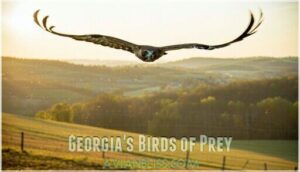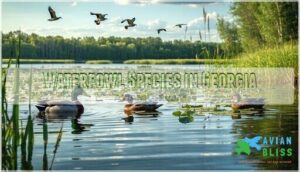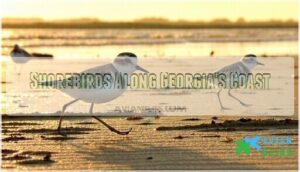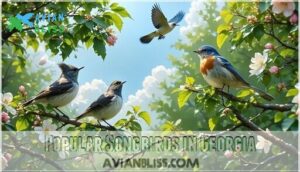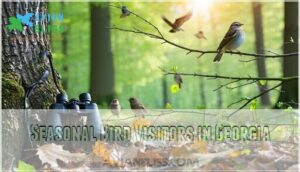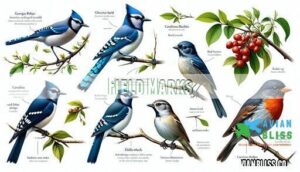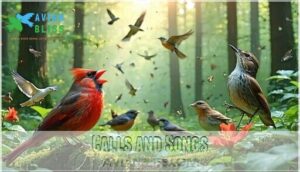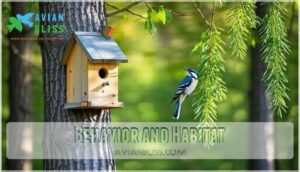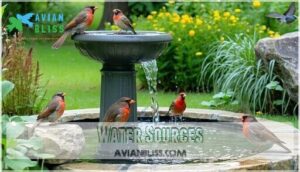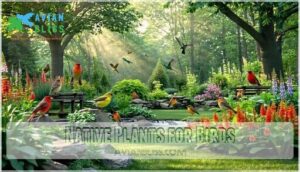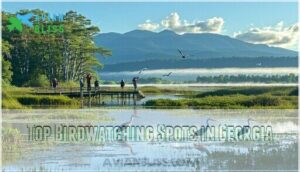This site is supported by our readers. We may earn a commission, at no cost to you, if you purchase through links.
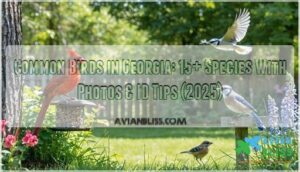 Georgia’s birdlife is a colorful mix of charm and utility.
Georgia’s birdlife is a colorful mix of charm and utility.
You’ll spot Northern Cardinals flaunting their fiery plumage in backyards, while Carolina Wrens belt out songs louder than their tiny frames suggest.
Blue Jays, with their striking blue feathers, are bold and clever, often stealing the spotlight (and peanuts).
Keep an eye out for Red-shouldered Hawks patrolling the skies or Great Horned Owls hooting from the shadows.
Along the coast, shorebirds like Killdeer and Sanderlings dart across sandy stretches.
Whether it’s woodpeckers drumming on trees or mockingbirds mimicking tunes, Georgia’s feathered residents never fail to impress, making you ready to attract them with their unique behaviors, such as woodpeckers drumming and mockingbirds mimicking.
Table Of Contents
- Key Takeaways
- Most Common Backyard Birds in Georgia
- Georgia’s Birds of Prey
- Waterfowl Species in Georgia
- Shorebirds Along Georgia’s Coast
- Popular Songbirds in Georgia
- Woodpeckers of Georgia
- Seasonal Bird Visitors in Georgia
- Identifying Georgia’s Birds
- Attracting Birds to Your Georgia Backyard
- Top Birdwatching Spots in Georgia
- Frequently Asked Questions (FAQs)
- Are there bird estuaries in Georgia?
- Are there migratory birds in Georgia?
- How do you identify a bird in Georgia?
- What is the most common bird in Georgia?
- How do I identify a bird in my backyard?
- What is the brown speckled bird in Georgia?
- What are the big birds in Georgia?
- What are the national birds of Georgia?
- What is the most common bird to see?
- What is the brown bird in Georgia with a white chest?
- Conclusion
Key Takeaways
- You’ll often see Northern Cardinals, Carolina Wrens, Tufted Titmice, and Blue Jays in Georgia backyards, with cardinals leading bird counts statewide.
- Georgia’s birds display unique behaviors like woodpeckers storing food in tree crevices and mockingbirds mimicking over 200 sounds, including mockingbirds mimicking.
- Seasonal shifts bring migratory birds like Painted Buntings in summer and Dark-eyed Juncos in winter, adding variety to birdwatching.
- Attract birds by offering diverse feeders, fresh water sources, and native plants to create a welcoming habitat.
Most Common Backyard Birds in Georgia
You’ll spot these four feathered friends at your backyard feeders more than any other species in Georgia, with Northern Cardinals showing up at over 63% of bird counts statewide.
Northern Cardinals brighten Georgia backyards year-round, leading bird counts with their vibrant red feathers and cheerful songs.
They’re joined by Carolina Wrens, Tufted Titmice, and Blue Jays, which round out this common quartet—they’re the reliable neighbors who’ll visit your yard year-round, whether you’re offering sunflower seeds or just watching from your kitchen window.
Northern Cardinal
You’ll spot the Northern Cardinal instantly with its brilliant red plumage and prominent crest.
These common Georgia birds are year-round residents, making them reliable backyard visitors.
Here’s what makes cardinals special among Georgia bird species:
- Males display vibrant red feathers while females sport warm brown tones
- Their distinctive "birdy-birdy-birdy" call echoes through neighborhoods
- Cardinal behavior includes courtship feeding during mating season
- Nesting habits favor dense shrubs and low trees
- Bird songs continue year-round, unlike many species
Carolina Wren
You’ll recognize the Carolina Wren by its rusty-brown feather colors and distinctive white eyebrow stripe.
This energetic georgia bird species loves dense shrubs and tangles in your backyard.
Their wren behavior includes cocking their tails upward while searching for insects.
These common georgia birds choose unusual nesting patterns, building homes in mailboxes, flower pots, or any cozy bird habitat they discover.
Tufted Titmouse
Looking like a tiny gray acrobat with a punk-rock mohawk, the Tufted Titmouse ranks among Georgia’s most beloved backyard birds.
You’ll hear its loud peter-peter-peter call echoing through neighborhoods as it performs aerial stunts at feeders.
This fearless little character exhibits fascinating bird behavior, boldly plucking hair from sleeping mammals for nesting habits.
Its diverse titmouse diet includes sunflower seeds, suet, and insects, making feather care essential for these active common birds in Georgia.
Blue Jay
Blue Jays dominate Georgia bird watching scenes with their brilliant cobalt feathers and punk rock crests.
These corvids showcase complex jay behavior – they’ll mimic hawk calls to scare competitors away from feeders, then swoop in for the prize.
Their Blue Jay habitat spans oak forests to suburban yards.
Listen for their harsh "jay-jay" bird calls echoing through neighborhoods.
During spring nesting patterns, pairs build stick platforms in tree forks, raising 3-5 speckled eggs.
Georgia’s Birds of Prey
You’ll spot Georgia’s raptors soaring overhead or perched on fence posts, scanning for their next meal with razor-sharp eyesight.
These skilled hunters include hawks that cruise open fields, tiny falcons that snatch insects mid-flight, and owls that hunt silently through the night.
Red-shouldered Hawk
Red-shouldered Hawks soar through Georgia’s wooded wetlands year-round, their rusty shoulders catching sunlight as they hunt.
These Georgia birds exhibit fascinating hawk behavior, returning to ancestral nesting sites with remarkable fidelity. Their piercing "kee-ah" calls echo through forests, making feather identification easier for birdwatching enthusiasts.
The species’ adaptive nature is evident in their ability to thrive in various woodland habitats.
Key characteristics of this bird species include:
- Distinctive rusty-red shoulder patches – visible during flight and perching
- Banded black-and-white tail – creates checkered pattern in flight
- Forest-edge habitat preference – near streams and wetlands for hunting
- Loud territorial calls – "kee-ah" vocalizations carry through woodlands
- Year-round Georgia residence – supporting local bird conservation efforts
American Kestrel
While Red-shouldered Hawks command attention, the American Kestrel steals the show as North America’s tiniest falcon.
You’ll find these pint-sized predators hovering over georgia bird watching hotspots, showcasing remarkable Kestrel Behavior as they hunt insects and small mammals.
| Feature | Male | Female |
|---|---|---|
| Head | Blue-gray crown | Rusty-brown cap |
| Wings | Blue-gray with spots | Rusty-brown barred |
| Size | 8.7-12.2 inches | Slightly larger |
| Hunting | Aerial acrobatics | Ground pouncing |
Their Feather Camouflage and Bird Nesting habits make them fascinating georgia bird species to observe during birdwatching in Georgia adventures.
Great Horned Owl
Georgia’s most formidable nocturnal predator, the Great Horned Owl, dominates the night with silent precision.
These apex hunters thrive in diverse Owl Habitat from forests to suburbs. Their exceptional Night Vision and Silent Flight make them unstoppable.
You’ll recognize their distinctive "hoo-h’HOO-hoo-hoo" call echoing through darkness.
- Feather Camo provides perfect woodland disguise
- Powerful talons crush prey with 300 pounds of pressure
- Hunting Tactics include ambush attacks from perches
- Large eyes gather light 100 times better than humans
- Flexible necks rotate 270 degrees for complete surveillance
Waterfowl Species in Georgia
You’ll spot Georgia’s waterfowl species paddling through lakes, ponds, and wetlands across the state year-round.
These aquatic birds include the familiar Mallard with its green head, the large Canada Goose that honks overhead in V-formations, and the colorful Wood Duck that nests in tree cavities near water.
Mallard
You’ll spot Mallards year-round in Georgia’s wetlands, making them the most recognizable waterfowl among georgia bird species.
Males flash iridescent green heads while females sport mottled brown plumage—perfect camouflage for nesting duties.
| Feature | Male | Female |
|---|---|---|
| Head Color | Glossy green | Mottled brown |
| Bill | Yellow-green | Orange-brown |
| Body | White collar, chestnut breast | Brown streaked |
These adaptable ducks dabble for aquatic plants and insects, demonstrating classic waterfowl diet preferences that make them successful georgia backyard birds.
Canada Goose
Unlike mallards, Canada geese dominate Georgia’s waterways with their commanding presence and distinctive honking calls.
These large waterfowl have adapted remarkably well to urban environments, making them one of Georgia’s most recognizable bird species.
You’ll find them grazing on grass like feathered lawnmowers in parks and golf courses.
Canada geese showcase fascinating behaviors throughout Georgia:
- Flock behavior creates V-shaped formations during flight, reducing wind resistance
- Nesting sites are fiercely defended territories near water sources
- Feather care involves preening sessions that strengthen pair bonds
Their migration patterns have shifted dramatically due to habitat loss.
Wood Duck
Why do Wood Ducks (Aix sponsa) look like they’re dressed for a fancy dinner?
These stunning water fowl sport iridescent green heads and chestnut breasts that’ll make you do a double-take.
You’ll find these Georgia bird species in wooded swamps and streams, where they master the art of nesting in tree cavities.
Their wood duck habitat includes marshes throughout the state.
During duck migration seasons, watch for their distinctive calls echoing across wetlands as they practice fastidious feather care.
Shorebirds Along Georgia’s Coast
You’ll find Georgia’s coastal shorebirds performing their daily feeding routines along sandy beaches and mudflats, where species like Killdeer, Spotted Sandpiper, and Sanderling showcase distinct foraging behaviors.
These birds offer excellent identification opportunities as they probe sand for invertebrates or run along the water’s edge with their characteristic stop-and-go movements, exhibiting unique behaviors that aid in recognition.
Killdeer
This adaptable shorebird breaks the mold by thriving far from water.
You’ll find Killdeer in Georgia’s diverse landscapes, from coastal mudflats to suburban lawns.
Their distinctive "kill-deer" call and broken-wing distraction display make identification easy.
Killdeer Habitat includes:
- Short-grass areas – golf courses and athletic fields
- Agricultural zones – pastures and plowed fields
- Urban spaces – parking lots and gravel driveways
- Wetland edges – mudflats and sandy shores
Their insect-heavy diet provides natural pest control for Georgia properties.
The state’s shorebird conservation efforts, such as those at Barrier Island sites, play a vital role in protecting these species.
Spotted Sandpiper
The Spotted Sandpiper, a lively shorebird, charms with its constant tail bobbing.
Found along Georgia’s streams, lakes, and coasts during migration, it thrives on insects and crustaceans.
Males surprisingly handle incubation and chick care—a rare twist in bird parenting.
Understanding coastal bird species is essential for effective conservation efforts.
| Feature | Description | Fun Fact |
|---|---|---|
| Tail Bobbing | Constant motion | Helps with bird identification |
| Diet | Insects, crustaceans | Feeds near water edges |
| Nesting | Male incubates eggs | Unique among shorebirds |
Sanderling
Sanderlings bring a lively charm to Georgia’s beaches, darting in sync with the waves like nature’s little dancers.
These energetic shorebirds migrate from Arctic breeding grounds, making coastal foraging a daily ritual. Their pale winter plumage blends beautifully with sandy shores as they probe for crustaceans during tidal feeding.
Watching a flock of sanderlings scurry is pure joy, showcasing the magic of bird species in motion. Add them to your Georgia bird species list for unforgettable birdwatching!
Popular Songbirds in Georgia
You’ll find Georgia’s popular songbirds like the Northern Mockingbird, Eastern Bluebird, and American Robin filling the air with their melodies year-round.
These feathered vocalists are as much beautiful to watch as they’re fascinating in their behaviors, from mimicry to nesting habits.
Northern Mockingbird
The Northern Mockingbird is a master of mimicry, often imitating other birds, alarms, or even dogs.
Found perched high in Georgia’s urban and rural areas, it’s a bold insect hunter and a frequent visitor to backyards.
- Mockingbird Songs: Over 200 melodies in their repertoire.
- Nesting Patterns: Shrubs and small trees.
- Feeding Habits: Insects, berries, and fruit.
- Urban Adaptation: Thrives in human-dominated spaces.
Eastern Bluebird
Eastern Bluebirds, one of Georgia’s most adored bird species, captivate with their vivid blue feathers and warm, rusty chests.
They’re cavity nesters, often spotted using bluebird boxes in backyards or open woodlands.
Their diet shifts with seasons, from munching on insects in summer to berries in winter.
While many stay in Georgia year-round, some follow migration patterns.
Keep an eye out—these cheerful songbirds bring life and color to any outdoor birdwatching adventure!
American Robin
You’ll frequently see American Robins darting across lawns, their bold orange-red breasts standing out.
These adaptable songbirds thrive in diverse habitats, from city parks to woodlands, making them a favorite for birding in Georgia.
Their cheerful "cheer-up, cheerily" song greets early risers.
Robins are famous for their nesting patterns, building sturdy cup-shaped nests and laying striking blue eggs.
Watch their quirky feeding habits—pausing mid-hop to "listen" for worms.
Truly iconic among Georgia backyard birds!
Woodpeckers of Georgia
You’ll find Georgia’s woodpeckers hard at work, chiseling away at tree trunks with their powerful beaks.
From the flashy red-bellied woodpecker to the tiny, energetic downy woodpecker, these birds are nature’s percussionists, each with its own rhythm and style.
Red-bellied Woodpecker
The Red-bellied Woodpecker, despite its name, shows more red on its head than its belly.
Found in Georgia’s forests and suburban areas, it’s a favorite among birdwatchers. You’ll often spot them at feeders enjoying suet or peanuts.
Their loud, rolling “churr” call is unmistakable. Understanding the woodpecker conservation efforts is essential for protecting these species.
- Fun Facts:
- They store food in tree crevices for later.
- Their tongue extends nearly two inches past their beak!
- They’re known for their acrobatic foraging skills.
Downy Woodpecker
If you’ve ever spotted a tiny woodpecker pecking away in your backyard, chances are it’s the Downy Woodpecker.
Known for its petite size and distinctive black-and-white plumage, this charming bird thrives on a woodpecker diet of insects, seeds, and berries.
They’re frequent suet-feeding visitors, making them easy to attract.
With their energetic pecking behavior, these Georgia birds are a delight for birdwatchers seeking simple georgia bird identification in parks or gardens.
Northern Flicker
The Northern Flicker stands out among Georgia birds with its ground-foraging habits and striking plumage.
You’ll spot this woodpecker in Flicker Habitat like open woodlands and parks, often hunting ants with its curved bill.
Known for Flicker Migration southward in winter, it thrives on a Woodpecker Diet of insects, fruits, and seeds.
Their quirky, tree-cavity nests make them unforgettable.
Seasonal Bird Visitors in Georgia
You’ll notice Georgia’s bird population changes with the seasons, bringing unique visitors like wintering sparrows and summer-breeding warblers.
These seasonal shifts offer a chance to spot species you won’t see year-round, so keep your binoculars handy!
Winter Migrants
Winter in Georgia brings a flurry of migratory birds, offering a feast for the eyes.
Watch for:
- Dark-eyed juncos hopping on frosty lawns.
- White-throated sparrows serenading from hedges.
- Buffleheads diving gracefully along coastal waters.
These winter birds adapt to cold weather with exceptional feather care and flock behavior.
Keep feeders stocked with seeds to support their journey.
Georgia bird migration transforms backyards into havens for these migratory species—nature’s way of celebrating the season!
Summer Breeding Birds
Summer in Georgia is a lively season for birdwatching, with countless Georgia bird species showcasing their breeding habits.
From vibrant Painted Buntings to the melodic Summer Tanager, these birds establish nesting sites in forests, fields, and even your backyard.
Fledgling care is a highlight as young birds take their first flights.
Curious about their summer diet or bird species identification? Here’s a quick guide:
| Species | Nesting Sites | Summer Diet |
|---|---|---|
| Painted Bunting | Dense shrubs | Seeds, insects |
| Summer Tanager | Tree canopies | Bees, wasps |
| Ruby-throated Hummingbird | Flower gardens | Nectar, small bugs |
Spring and Fall Transients
Spring and fall bring a parade of transient birds to Georgia, making it a hotspot for bird migration patterns.
Warbler migration steals the show, with colorful species flitting through seasonal habitats. Hawk watches reveal transient raptors soaring above. Fall songbirds like thrushes and vireos add melody to forests and parks.
Georgia’s bird species diversity shines in coastal areas and bird sanctuaries. Keep your binoculars handy—these fleeting visitors are worth the effort! Understanding bird migration routes is essential for spotting these species.
- Top sightings include:
- Warblers like yellow-throated and chestnut-sided.
- Thrushes such as the veery and hermit thrush.
- Blue-gray gnatcatchers in early spring.
- Migratory hawks, including red-tailed and sharp-shinned.
- Vireos like the blue-headed and white-eyed.
Identifying Georgia’s Birds
You can spot Georgia’s birds by focusing on key traits like plumage patterns, calls, and behaviors.
Pay attention to their habitats too—sometimes a bird’s favorite hangout is the biggest clue!
Field Marks
Spotting Georgia birds gets easier when you focus on field marks like beak shapes, feather patterns, and wing bars.
Look for details in head plumage, tail feathers, or even an eyebrow stripe.
These clues reveal a bird’s identity, from a Blue Jay’s bold crest to a Carolina Wren’s white eyebrow.
Birdwatching becomes a treasure hunt—each mark tells a story about the bird species you’re observing!
Calls and Songs
Bird calls and songs are a fascinating way to identify species in Georgia.
Each bird has unique vocal traits like melodic structures or call frequencies.
The Northern Cardinal sings a cheerful “cheer-cheer-cheer,” while Carolina Wrens belt out a rhythmic “teakettle-teakettle.”
Paying attention to these auditory signals helps you connect with nature and better understand bird behavior, making bird vocalizations an enjoyable skill to master.
Understanding bird song patterns is essential for accurate identification and appreciation of Georgia’s avian diversity, and it helps you connect with nature.
Behavior and Habitat
Understanding bird behaviors and habitats makes identification easier.
Observe feeding patterns, like woodpeckers hammering bark or warblers darting for insects.
Nesting habits are clues too—bluebirds prefer tree cavities, while killdeer nest on open ground.
Bird migration also plays a role; some Georgia birds stay year-round, others just pass through.
Habitat preferences matter—forests, wetlands, or backyards reveal much.
Protecting these bird habitats through conservation guarantees future birdwatching in Georgia’s wildlife refuges stays rewarding and vibrant with year-round activities.
Attracting Birds to Your Georgia Backyard
You can turn your Georgia backyard into a bird haven with a few simple steps.
By offering the right food, fresh water, and native plants, you’ll attract everything from cheerful chickadees to colorful cardinals.
Bird Feeders and Food Types
If you’re keen to welcome Georgia birds, feeders are your best bet!
Offer a smorgasbord of seeds to suit different bird diets.
- Black oil sunflower seeds: A favorite for cardinals and finches.
- Nyjer seeds: Perfect for goldfinches.
- Suet cakes with nuts: Irresistible to woodpeckers.
Using the right bird feeder types can enhance your bird-watching experience.
Place feeders where birds feel safe, and watch the magic happen!
Water Sources
Why not turn your yard into a bird oasis?
A simple birdbath or fountain system can draw Wetland Birds and others seeking a splash. Keep water shallow (under 2 inches) and fresh.
Add movement—like a dripper—for extra allure. Whether it’s Pond Life or Georgia Water Birds, these features make birdwatching in Georgia’s lakes, rivers, and backyards unforgettable!
Creating a birdbath fountain can be an essential part of attracting birds to your yard.
Native Plants for Birds
Native plants are a lifeline for Georgia’s diverse ecosystem, offering food and shelter for native birds.
Create a bird-friendly garden by layering vegetation to mimic natural habitats. Using native plant seeds is essential for maintaining healthy native plant ecosystems.
- Choose seed-producing trees, native shrubs, and pollinator plants.
- Avoid pesticides—they harm insects birds rely on.
- Opt for flower choices that attract hummingbirds and other nectar-loving species.
Top Birdwatching Spots in Georgia
You don’t have to travel far to enjoy Georgia’s incredible birdwatching spots.
From coastal marshes teeming with herons to mountain trails echoing with woodpecker calls, there’s something for every bird enthusiast.
Coastal Areas
Explore Georgia’s coastal birding hotspots along the Colonial Coast Birding Trail, where tidal zones and shoreline habitats teem with life.
Spot Coastal Birds like black skimmers and American oystercatchers thriving in these rich ecosystems.
Whether you’re exploring saltmarshes or scanning Georgia’s coastal waters, these birdwatching spots offer unforgettable glimpses of diverse sea birds while supporting important coastal conservation efforts.
Mountain Regions
Nestled in Georgia’s mountain habitat, birdwatching offers a front-row seat to nature’s drama.
The Blue Ridge Mountains boast prime birdwatching spots, showcasing highland species like the Canada Warbler and Dark-eyed Junco during migration.
These terrains highlight Georgia’s diverse ecosystem, blending forest ecology with stunning views.
Conservation efforts guarantee these habitats thrive, giving you a chance to witness unique Georgia bird species in action, and don’t forget binoculars—mountain birding is an adventure worth every step!
Urban Parks and Gardens
Georgia’s urban parks and gardens are teeming with Garden Birds and Urban Wildlife.
Piedmont Park in Atlanta showcases Park Habitats perfect for spotting woodpeckers and warblers. Cochran Shoals, part of Chattahoochee River National Recreation Area, buzzes with hummingbirds.
These Green Spaces offer a glimpse into City Ecosystems where Georgia bird species thrive.
Join local birding groups to explore Georgia birding trails and enrich your birdwatching in Georgia’s parks experience.
Frequently Asked Questions (FAQs)
Are there bird estuaries in Georgia?
You bet Georgia’s got bird estuaries!
Picture nature’s bustling airports—like Harris Neck National Wildlife Refuge—where migratory birds refuel and mingle.
These wetlands teem with herons, egrets, and shorebirds, offering you a front-row seat to avian drama.
Are there migratory birds in Georgia?
You’ll find plenty of migratory birds in Georgia, like ruby-throated hummingbirds and yellow-bellied sapsuckers.
These travelers stop by during seasonal shifts, seeking food, nesting spots, or warmer climates.
Keep feeders ready—they’ll appreciate it!
How do you identify a bird in Georgia?
Look for key features like size, color patterns, and unique markings.
Observe behaviors, habitats, and calls. A red crest might signal a woodpecker, while mimicked tunes often reveal a Northern Mockingbird.
Keep binoculars handy!
What is the most common bird in Georgia?
Funny how nature works—Georgia’s most common bird, the Northern Cardinal, is like the rock star of backyards.
With its bright red plumage and bold personality, it’s easy to spot and impossible to ignore!
How do I identify a bird in my backyard?
Notice its size, colors, and patterns.
Watch behaviors like hopping or gliding. Listen for unique calls.
Check its habitat—forest, feeder, or ground. A field guide or app can help pinpoint the species.
A field guide or app can be very useful.
What is the brown speckled bird in Georgia?
You’re likely spotting a Song Sparrow or a Brown Thrasher.
Both flaunt brown speckles, but the Thrasher’s larger with a curved bill, while the sparrow’s smaller with a melodious, varied song.
What are the big birds in Georgia?
Georgia’s big birds include the majestic Great Blue Heron, soaring Red-tailed Hawk, and striking Pileated Woodpecker.
You’ll spot them near water, forests, or open fields, showcasing their impressive wingspans and commanding presence in the wild.
What are the national birds of Georgia?
Georgia doesn’t have an official national bird, but the Northern Cardinal is a strong contender.
Its vibrant red feathers and cheerful song make it a beloved symbol, often seen brightening backyards and woodlands year-round.
What is the most common bird to see?
Ever notice a flash of red darting through your yard?
The Northern Cardinal tops the list, with its bold color and melodic songs.
These year-round residents love feeders and brighten any backyard with charm.
What is the brown bird in Georgia with a white chest?
You’re likely spotting a Song Sparrow.
It’s a brown bird with a streaked white chest, often seen flitting around shrubs or singing its heart out.
Their cheerful melodies can brighten any backyard moment!
Conclusion
Isn’t it amazing how many common birds in Georgia bring life to your surroundings?
From the bold Blue Jays to the melodic Northern Cardinals, each species offers unique behaviors to observe.
Whether you’re filling feeders, planting native shrubs, or simply watching the skies, there’s always an opportunity to connect with nature.
By learning their habits and calls, you’ll deepen your appreciation for these feathered friends while creating a haven for them in your own backyard.
- https://www.bbc.com/future/article/20191211-crows-could-be-the-smartest-animal-other-than-primates
- https://www.youtube.com/birdwatchinghq
- https://ebird.org/home
- https://www.allaboutbirds.org/guide/Northern_Cardinal/maps-range
- https://feederwatch.org/blog/when-invasive-species-clash-competition-between-the-house-sparrow-and-house-finch/

